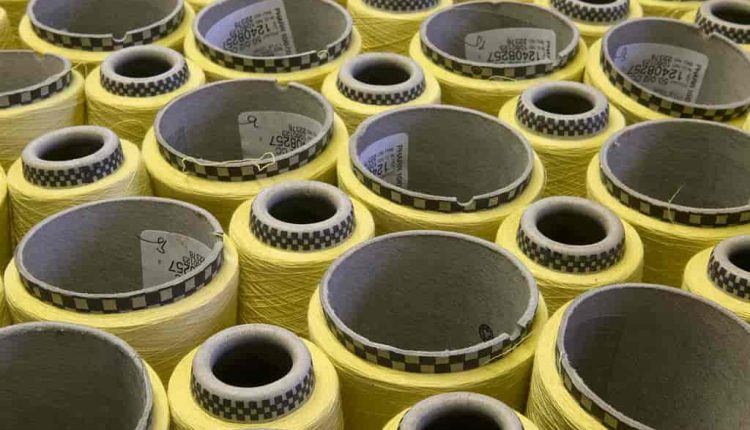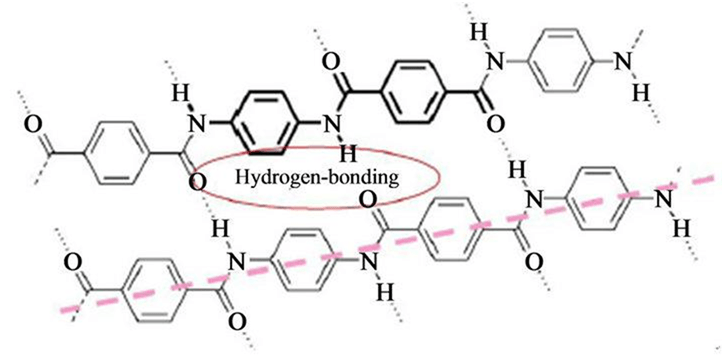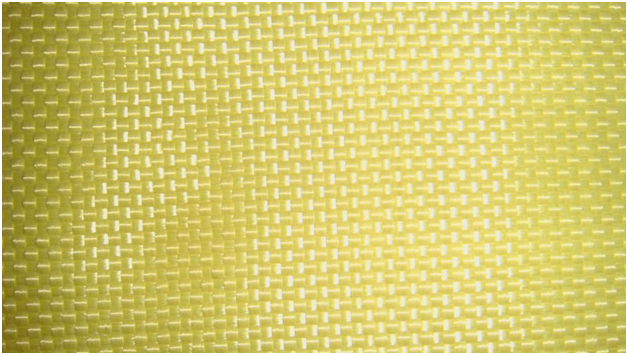Aramid fibre – a modified form of polyamide Nylon
"Aramid" is formed with a combination of words Ar (Aromatic) + amid (Amides)
ARAMID is a synthetic fibre that is produced by spinning a solid fibre from solution. The initial preparation of the polymer is generally achieved by a chemical reaction between the amine group and a carboxylic acid halide group.

Aramid fibre is an innovation and modified form of polyamide Nylon. Further innovations were carried out to develop a fibre which can have enormous advantages over nylon fibres and possess unique properties such as ultra-high strength, rigid & highly oriented molecular structure, lightweight, low flammability, resistance to abrasion & organic solvents, etc. The Aramid fibres were developed which means Ar—-Aromatic, and amid—Amides.
Two aromatic rings are attached to Amide linkages and are called aromatic polyamides. These are classified in two forms with their trade names Nomex (meta-aramid) and Kevlar (para-aramid). These two are most common. The other names are Twaron, technora, Heracron, etc. They are modified forms of polyamides (Nylon, Polyester)
ARAMID is a synthetic fibre that is produced by spinning a solid fibre from solution. The initial preparation of the polymer is generally achieved by a chemical reaction between the amine group and a carboxylic acid halide group. Once the polymer has been produced, the aramid fibre is then created by spinning. This was developed by DuPont with their trade name Kevlar fibre and Teijin developed Twaron fibre. There are many grades available in the market with properties to suit their applications, especially in aerospace and military industries. The inherent bond strength is due to the orientation of molecules along the fibre axis. Aramid is a synthetic fibre that is produced by spinning a solid fibre from solution. The initial preparation of the polymer is generally achieved by a chemical reaction between the amine group and a carboxylic acid halide group. Once the polymer has been produced, the aramid fibre is then created by spinning.

Kevlar is manufactured from a polymer which is highly insoluble in the solution and needs to add concentrated sulfuric acid. This is necessary to keep the highly insoluble polymer in solution form during synthesis and spinning.
The manufacturing process of Kevlar is expensive and dangerous partly because it is dissolved in concentrated sulfuric acid. Unlike HDPE high molecular weight polyethylene, the kevlar® molecule is polar. This property allows other substances including water to attach themselves to the Aramid. This allows it to be more active chemically than UHMWPE (Dyneema®, Spectra®) It also means it can be bonded for example to epoxy, and it is wettable.
DuPont™ Kevlar® is an organic fibre in the aromatic polyamide family. The unique properties and distinct chemical composition of wholly aromatic polyamides (aramids) distinguish them – and especially Kevlar® – from other commercials, man-made fibres.
Kevlar® has a unique combination of high strength, high modulus, toughness and thermal stability. It was developed for demanding industrial and advanced-technology applications. Currently, many types of Kevlar® are produced to meet a broad range of end uses.
Aramid definition—This product has been defined in different ways as per their inherent properties by different researchers.
- any of a class of synthetic polyamides that are formed from aromatic monomers, and yield fibres of exceptional strength and thermal stability.
- any of a class of synthetic aromatic long-chain polyamides capable of extrusion into fibres having resistance to high temperatures and great strength.
- any of a group of synthetic fire-resistant and strong polyamides used to make textiles or plastics
- any of a group of lightweight but very strong heat-resistant synthetic aromatic polyamide materials that are fashioned into fibres, filaments, or sheets and used especially in textiles and plastics.
- any of various flame-resistant and strong synthetic fibres used in.
- Keany of a class of synthetic aromatic long-chain polyamides capable of extrusion into very strong heat-resistant fibres.
- English dictionary definition of aramid fibre. n. A strong, heat-resistant fibre formed of polymers with repeating aromatic groups branching from a carbon backbone, having flame retardant properties
- The word aramid comes from a blend of the words “aromatic” and “polyamide” and is a general term for a manufactured fiber in which the fiber-forming substance is a long chain synthetic polyamide, in which at least 85% is of amide linkages (-CO-NH-) attached directly to two aromatic rings, (as defined by the U.S Federal)
Aramid fibre characteristics
LONG CHAIN SYNAPTIC POLYMIDE AT LEAST 85% AMIDE (-CO-NH-) linkages are attached directly between two aromatic rings. Molecular structure made of linked Benzene rings and amide bonds.
Fibre structure: The molecules form a planar array with weak interchain hydrogen bonding easily fibrillated up on the fracture. Radially arranged axially pleated crystalline supramolecular sheets.


Kevlar is a kind of polyamide. Its amide groups are separated by para-phenylene groups. That is, the amide groups attach to the phenyl rings opposite to each other, at carbons 1 and 4.

Physical properties
Optical properties
- Colour—Nomex= white, Kevlar= golden
- Luster—Depends on cross-section shape, circular= more lustre, dog bone=less lustre compared to circular, note—luster can be controlled by finishes.
- Effect of rays—Beta = No effect, Gamma= No effect, UV rays= Starts to degrade and loose strength.
| Manufacturer | Dupont | Hyosung | Kolon | Teijin | Teijin | |
| Trade Name | Kevlar®29 | Alkex®AF-1000 | Heracron®HF200 | Twaron® | Technora® | |
| Specification | UofM | |||||
| Density | (g/cm3) | 1.44 | 1.44 | 1.44 | 1.44 – 1.45 | 1.39 |
| Tenacity | (g/den) | 23 | 23 | 23.0-24.0 | 18.7 – 28.3 | 28.3 |
| Modulus | (Gpa) | 70.33 | 70 – 102 | 8. – 109 | 60 – 120 | 74 |
| Elongation @ Break | (%) | 3.6 | 2.8 – 4.2 | 2.8 – 3.6 | 2.2 – 4.4 | 4.5 |
| Moisture Regain | (%) | 7 | 4.5 | not avail | 3.2 – 5.0 | 1.9 |
| Decomposition | (°C) | 427 – 482 | 500 | not avail | 500 | 500 |
| (°F) | 800 – 900 | 932 | not avail | 932 | 932 | |
| Material | Strength-to-weight KN.m/kg. | Ultimate Tensile Strength MPa | Density g/cm3 |
| Kevlar | 2514 | 2757 | 1.44 |
| Carbon Fiber | 2457 | 4137 | 1.75 |
| E Glass Fiber | 1307 | 3450 | 2.57 |
| Carbon Laminate | 785 | 1600 | 1.5 |
| E Glass Laminate | 775 | 1500 | 1.97 |
| Nylon | 69 | 75 | 1.15 |
RELATED POSTS
High Young’s Modulus (structural rigidity): 130-179 GPa. While carbon fiber is 300 Gpa and glass 81 GPa. (Young’s Modulus: Also known as elastic modulus. It defines the relationship between stress and strain in a material)
Properties of Commercial Aramid Fibers
| Material | Young’s Modulus GPa |
| Aramid(such as Kevlar and Twaron) | 70.5-112.4 |
| Nylon | 2-4 |
| Polypropylene | 1.5-2 |
| Fiber Type | Density g/cm3 | Extension to Break % | Modulus GPa | Loop Elongation % |
| Kevlar29 | 1.43 | 3.6 | 70 | 2.1 |
| Kevlar49 | 1.45 | 2.8 | 135 | 1.3 |
| Kevlar119 | 1.44 | 4.4 | 55 | 2.7 |
| Kevlar129 | 1.45 | 3.3 | 99 | |
| Kevlar149 | 1.47 | 1.5 | 143 | 0.6 |
| Nomex | 1.38 | 22 | 17 | |
| Twaron | 1.44 | 3.3 | 79 | |
| Twaron HM | N/a | 2 | 123 | |
| Technora | 1.39 | 4.3 | 70 | |
| Technora V106 | 1.32 | 3.7 | 77 |
Mechanical properties
Tenacity (g/d) = Dry—Nomax-4.0—5.3, Kelver-18 —26.5, Wet—-Nomex—3.0—5.3, Kevlar—17—25.9. (very high in compared to nylon)
Nomex and related aramid polymers are related to nylon but have an aromatic backbone, and hence are more rigid and more durable. Nomex is the premier example of a meta variant of the aramids (Kevlar is a para-aramid). Unlike Kevlar, Nomex cannot align during filament formation and has poorer strength. However, it has excellent thermal, chemical, and radiation resistance for polymer materials.
A series of synthetic polymers in which repeating units containing large phenyl rings are linked together by amide groups. Amide groups (CO-NH) form strong bonds that are resistant to solvents and heat. Phenyl rings (or aromatic rings) are bulky six-sided groups of carbon and hydrogen atoms that prevent polymer chains from rotating and twisting around their chemical bonds.
- Moisture regains: Kevlar—1.2—4.3%, Nomex—6.5%, Non -flexible chains. Reason: two alternate rings try to oppose each other by repulsion of aromatic rings which keeps the fibres straight and non-flexible. Hydrogen bonding between chains thereby forming a sheet-like structure (OF FIBRILS). Fibrils (sheets)separated by elongated voids. Reason: because each sheet is a plane whose both faces are negatively charged because of Aromatic rings due to this elongated void is created between fibril sheets.
- Fibre properties: They are characterized by medium to ultra-high strength, medium to low elongation and moderately high to ultra-high modulus with the densities ranging from 1.38g/cm3 to 1.47g/cm3. Heat-resistant and flame-resistant aramid fibres contain high proportion or meta-oriented phenylene rings, whereas ultra-high strength high-modulus fibres contain mainly para-oriented phenylene rings.
- Aramid yarn has a breaking tenacity of 3045 MPa, in other words, more than 5 times than this of steel (under water, aramid is 4 times stronger) and twice than this of glass fibre or nylon. High strength is a result of its aromatic and amide group and high crystallinity. Aramid retains strength and modulus at temperatures as high as 300 degrees Celsius. It behaves elastically under tension. When it comes to severe bending, it shows non-linear plastic deformation. With tension fatigue, no failure is observed even at impressively high loads and cycle times. Creep strain for aramid is only 0.3%.
- Chemical properties: All aramids contain amide links that are hydrophilic. However, not all aramid products absorb moisture the same. The PPD-T (poly-phenylene terephthalamide) fibre has very good resistance to many organic solvents and salt, but strong acids can cause substantial loss of strength. Aramid fibres are difficult to dye due to their high Tg. Also, the aromatic nature of para-aramid is responsible for oxidative reactions when exposed to UV light, that leads to a change in colour and loss of some strength.
- Resistance to Alkalis—Dilute 9AT ROOM TEMP.) —-NO EFFECT TO Nomex, and Kevlar but at high temperatures, it weakens both. Resistance to Dye—Because of high negative charge repulsion it is hard to dye but in extreme conditions support electrophilic substitution reactions. Resistance to bleach—Resistance to bleach that is why it is hard to change its natural golden colour of Kevlar.
- Thermal properties: Aramid fibres do not melt in the conventional sense but decompose simultaneously. They burn only with difficulty because of Limited Oxygen Index (LOI) values. It should be mentioned that at 300 degrees Celsius some aramid types can still retain about 50% of their strength. Aramids show high crystallinity which results in negligible shrinkage at high temperature.
To sum up, aramid general characteristics are:
- High strength
- Resistance to absorption
- Resistance to an organic solvent, good chemical resistance
- No conductivity
- No melting point
- Low flammability
- Excellent heat, and cut resistance
- Sensitive to acids and ultraviolet radiation

Aramid application

Aramid fibre applications are divided into two categories:
- Reinforcement in composites like sports goods, aircraft, military vehicles and many other.
- Fabrics in clothing such as fire protection clothes or bulletproof vests.
More elaborative uses of aramid are:
- Various forms of composite materials
- Sailcloth
- Snowboards
- Protective gloves, helmets, body armour
- Filament wound pressure vessels
- Flame and cut resistant clothing
- Asbestos replacement
- Ropes and cables
- Optical fibre cable systems
- Jet engine enclosures
- Tennis strings and hockey sticks
- Wind instrument reeds
- Reinforcement for tyres and rubber goods
- Circuit board reinforcement
Although every application meets its own requirements, almost all of them share aramid’s major characteristics: high strength, high modulus, high toughness, thermal dimensionality stability, low creep and lightweight.
Advantages
Aramid main advantages are high strength and low weight. Like graphite, it has a slightly negative axial coefficient of thermal expansion, which means aramid laminates can be made thermally stable in dimensions. Unlike graphite, it is very resistant to impact and abrasion damage. It can be made waterproof when combined with other materials like epoxy. It can be used as a composite with rubber retaining its flexibility. High tensile modulus and low breakage elongation combined with very good resistance to chemicals make it the right choice for different composite structural parts in various applications.
Disadvantages
On the other side, aramid has a few disadvantages. The fibres absorb moisture, so aramid composites are more sensitive to the environment than glass or graphite composites. For this reason, it must be combined with moisture resistant materials like epoxy systems. Compressive properties are relatively poor too. Consequently, aramid is not used in bridge building or wherever this kind of resistance is needed. Also, aramid fibres are difficult to cut and to grind without special equipment (e.g. special scissors for cutting, special drill bits). Finally, they suffer some corrosion and are degraded by UV light. For this reason, they must be properly coated.
Major Application of Aramid Fibers
Thanks to the outstanding properties of aramid fibres, they can be used in a wide variety of industries.
- Flame-resistant clothing: For example, military MIL-G-181188B suits. This includes Heat-protective clothing and helmets.
- Substitute for asbestos (e.g. brake linings), whose fibres will give rise to pulmonary diseases after being inhaled into the lungs.
- Hot air filtration fabrics
- Reinforced thermoplastic pipes
- Bullet-proof wear: Body armour, competing with PE-based fibre products such as Dyneema and Spectra.
- Composite materials and they are often combined with carbon fibre.
- Tires, most recently as Sulfron (sulfur-modified Twaron)
- Mechanical rubber reinforcement
- Ropes and cables, although severe weakening under impact limits its use on boats and climbing. Aramid cables more applicable to static load situations, for example, the cables used as guy-wires for hydro tower erection for Hydro Quebec.
- Wicks for fire dancing
- Optical fibre cable systems
- Sailcloth (not necessarily racing boat sails)
- Sporting equipment
- Drumheads
- Wind instrument reeds, such as the Fibracell brand
- Loudspeaker diaphragms
- Boat hull material
- Fibre-reinforced concrete
- Tennis strings (e.g. by Ashaway and Prince tennis companies)
- Hockey sticks (normally in composition with such materials as wood and carbon)
- Snowboards
- Jet engine enclosures








